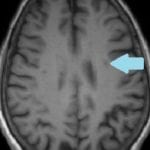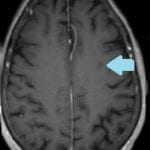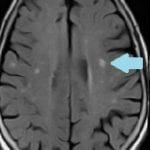Summary
Multiple sclerosis (MS) is an immune-mediated process where the body’s immune system attacks the central nervous system. This causes inflammation that damages myelin which the insulation around nerve fibers. This can causes an impact on sensory and motor function. The cause of MS is unknown.
- Risk factors for MS involve lw vitamin D levels in blood.This can be caused by low amount of sunlight exposure.
- Smoking increases a persons risk of developing MS.
- Obesiity in childhood and adolescences should an increased risk.
- Women are 2-3x more likely to be diagnosed with MS.
- Individuals between the ages of 20 and 50 are at risk.
There is no cure for MS.
There are different types of MS:
https://www.nationalmssociety.org/What-is-MS/Types-of-MS
MRI Images
T1 Without Contrast

Hypointense areas may indicate permanent nerve damage.
T1 With Contrast

Enhancing lesion may indicate areas of active inflammation.
(Image does not show enhancing lesion)
FLAIR

Hyperintense areas will show MS activity with reduced interference from CSF.
Symptoms
- Fatigue
- Gait Difficultieis
- Numbness or tingling
- Spasticity
- Weakness
- Vision Problems
- Dizziness and Vertigo
- Bladder Problems.
- Sexual Problems
- Bowel problems
- Pain and Itching
- Cognitive Changes
- Emotional Changes
- Depression








